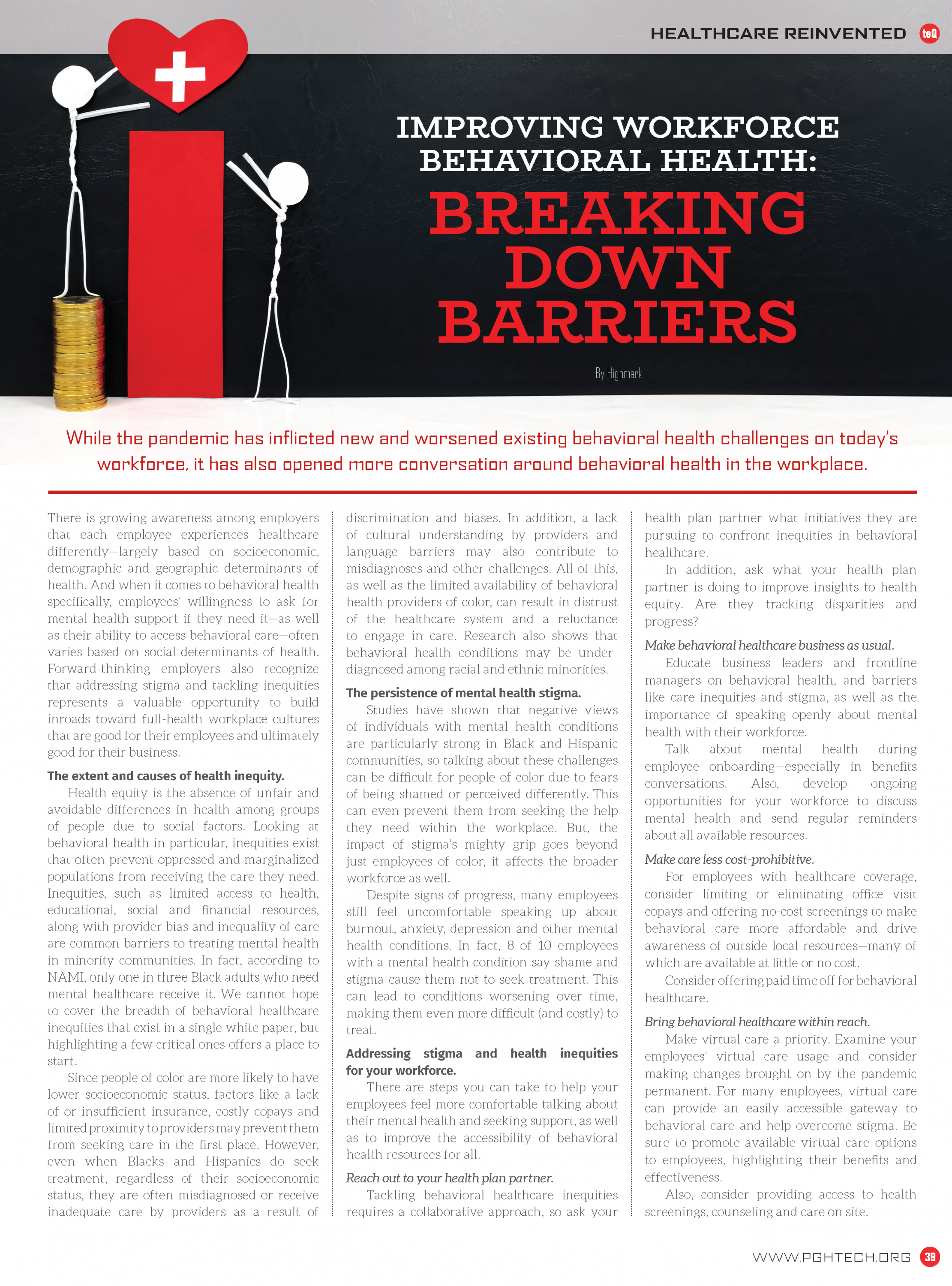Improving Workforce Behavioral Health: Breaking Down Barriers
By Highmark
 There is growing awareness among employers that each employee experiences healthcare differently—largely based on socioeconomic, demographic and geographic determinants of health. And when it comes to behavioral health specifically, employees’ willingness to ask for mental health support if they need it—as well as their ability to access behavioral care—often varies based on social determinants of health. Forward-thinking employers also recognize that addressing stigma and tackling inequities represents a valuable opportunity to build inroads toward full-health workplace cultures that are good for their employees and ultimately good for their business.
There is growing awareness among employers that each employee experiences healthcare differently—largely based on socioeconomic, demographic and geographic determinants of health. And when it comes to behavioral health specifically, employees’ willingness to ask for mental health support if they need it—as well as their ability to access behavioral care—often varies based on social determinants of health. Forward-thinking employers also recognize that addressing stigma and tackling inequities represents a valuable opportunity to build inroads toward full-health workplace cultures that are good for their employees and ultimately good for their business.
The extent and causes of health inequity.
Health equity is the absence of unfair and avoidable differences in health among groups of people due to social factors. Looking at behavioral health in particular, inequities exist that often prevent oppressed and marginalized populations from receiving the care they need. Inequities, such as limited access to health, educational, social and financial resources, along with provider bias and inequality of care are common barriers to treating mental health in minority communities. In fact, according to NAMI, only one in three Black adults who need mental healthcare receive it. We cannot hope to cover the breadth of behavioral healthcare inequities that exist in a single white paper, but highlighting a few critical ones offers a place to start.
Since people of color are more likely to have lower socioeconomic status, factors like a lack of or insufficient insurance, costly copays and limited proximity to providers may prevent them from seeking care in the first place. However, even when Blacks and Hispanics do seek treatment, regardless of their socioeconomic status, they are often misdiagnosed or receive inadequate care by providers as a result of discrimination and biases. In addition, a lack of cultural understanding by providers and language barriers may also contribute to misdiagnoses and other challenges. All of this, as well as the limited availability of behavioral health providers of color, can result in distrust of the healthcare system and a reluctance to engage in care. Research also shows that behavioral health conditions may be underdiagnosed among racial and ethnic minorities.
The persistence of mental health stigma.
Studies have shown that negative views of individuals with mental health conditions are particularly strong in Black and Hispanic communities, so talking about these challenges can be difficult for people of color due to fears of being shamed or perceived differently. This can even prevent them from seeking the help they need within the workplace. But, the impact of stigma’s mighty grip goes beyond just employees of color, it affects the broader workforce as well.
Despite signs of progress, many employees still feel uncomfortable speaking up about burnout, anxiety, depression and other mental health conditions. In fact, 8 of 10 employees with a mental health condition say shame and stigma cause them not to seek treatment. This can lead to conditions worsening over time, making them even more difficult (and costly) to treat.
Addressing stigma and health inequities for your workforce.
There are steps you can take to help your employees feel more comfortable talking about their mental health and seeking support, as well as to improve the accessibility of behavioral health resources for all. Reach out to your health plan partner. Tackling behavioral healthcare inequities requires a collaborative approach, so ask your health plan partner what initiatives they are pursuing to confront inequities in behavioral healthcare.
In addition, ask what your health plan partner is doing to improve insights to health equity. Are they tracking disparities and progress?
Make behavioral healthcare business as usual.
Educate business leaders and frontline managers on behavioral health, and barriers like care inequities and stigma, as well as the importance of speaking openly about mental health with their workforce. Talk about mental health during employee onboarding—especially in benefits conversations. Also, develop ongoing opportunities for your workforce to discuss mental health and send regular reminders about all available resources.
Make care less cost-prohibitive.
For employees with healthcare coverage, consider limiting or eliminating office visit copays and offering no-cost screenings to make behavioral care more affordable and drive awareness of outside local resources—many of which are available at little or no cost.
Consider offering paid time off for behavioral healthcare.
Bring behavioral healthcare within reach.
Make virtual care a priority. Examine your employees’ virtual care usage and consider making changes brought on by the pandemic permanent. For many employees, virtual care can provide an easily accessible gateway to behavioral care and help overcome stigma. Be sure to promote available virtual care options to employees, highlighting their benefits and effectiveness.
Also, consider providing access to health screenings, counseling and care on site.